by The Goat | Aug 27, 2019 | Grand Canyon
Where Does the Grand Canyon Begin and End?
Grand Canyon has a beginning, middle, and end just like any wonderful story. It unfolds with beautiful poetry like the most epic novels, films, and greatest stories ever told. It unfolds using astounding special effects, and comes to a close fit for the Oscar’s. Lyrical hyperbole aside, Grand Canyon does, in fact, begin and end in a very official way.
First, we need to pick which beginning and ending we are choosing. Do we choose time? Space? Map definition? Secondly, we must define where the beginning and end are for each of these definitions. Finally, we can choose which beginning and ending we like best!
Follow The Goat as he takes the road less traveled through time and space on the Colorado River.
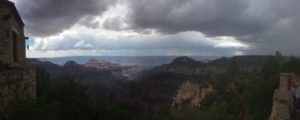
The Colorado River
To truly speak to the beginning and end of the Grand Canyon, one must first speak of the river that is responsible for its existence. The mighty Colorado River, with its headwaters in Rocky Mountain National Park, is the primary waterway of the American Southwest. It drains massive mountain ranges from Colorado, Utah, California, and Nevada. The Rocky Moutains, the Uintahs and Henry Mountain in Utah, and the Great Basin Range shed their waters into the Colorado River.
Geologist debate about the exact history of the river, but the most accepted theory is that it integrated roughly 6 million years ago. Before that, the Colorado had existed as two separate entities. In the north, lakes and such collected in basins that drained the Rockies and Uintas. In the south the river system drained the Great Basin and Gila Mountains, outletting into the Pacific Ocean. Action along the San Andreas Fault opened the Gulf of California which captured the lower drainage. The upper and lower rivers eventually were connected though various mechanisms like headward erosion, stream piracy, and springs integration (see our blog How Was Grand Canyon Formed?).
Today it courses 1,500 miles through the mountains and deserts to the Sea of Cortez in the Gulf of California. The banks of the Colorado are home to four National Parks and five National Monuments.
Don’t be fooled….
The Colorado River roils at 20,000 cubic feet per second, so its calm appearance is deceiving. Some of the most challenging whitewater in the American Southwest are found in the canyon depths. Two class 5 and ten class 4 rapids exist in Grand Canyon, along with nearly twenty class 3 and 2 rapid sections. A journey by boat though Grand Canyon is both exhilarating and death-defying. Above the river, the Tonto Trail winds 99 miles through nearly a third of Grand Canyon, providing a unique bird’s eye perspective of the Colorado River and a fabulous Inner Gorge experience.
National Parks: Rocky Mountain, Arches, Canyonlands, Grand Canyon
National Monuments: Colorado, Bears Ears, Grand Staircase-Escalante, Grand Canyon-Parashant
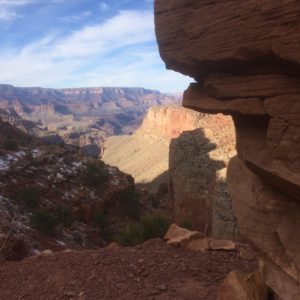
The Grand Canyon
The most stunning feature of the Colorado River is its Grand Canyon. Grand Canyon was named by Major John Wesley Powell, head of the United States Geological Survey. Powell was the first known person to successfully navigate the Colorado River through Grand Canyon by boat. He named several features along the Colorado River including Glen Canyon, Grand Canyon, The Gates of Lodore, and Flaming Gorge.
During his journey Powell documented the several rock layers present in the Canyon. These layers are the subject of our first option for Grand Canyon’s Beginning and End.
Time
Grand Canyon “began” 1.9 billion years ago as the North American continent was sutured together by drifting tectonic plates. This collision created a great seaside mountain range, and laid the foundation for everything. After that, hundreds of millions of years of sedimentation cycles occurred. Various oceans, rivers, and deserts covered the landscape and set the stage for deep dissection.
Similarly, Grand Canyon “began” six million years ago. Deep below the surface, faults slipped and created the East Kaibab Monocline. This wrinkle in the Earth’s crust altered the landscape, and forced a river to cut around and through it. The river was the Colorado, and its gash is known as the Grand Canyon.
Where does it end? I don’t know, but I can tell you what I think. The Earth is a dynamic system, always in motion. Major tectonic action exists in all directions. To the south, the crust is pulling down and away. To the west the North American and Pacific plates struggle for position. The southeast is the home of the Rio Grande Rift, and place where the North American continent is opening toward the Gulf of Mexico. The Colorado River carves it daily from the inside out.
Although it will take many millions of years, the actions of these various movements will affect Grand Canyon. The river will carve away the remaining sediment and level itself with the oceans. The uplifted Colorado Plateau will fall back down to sea level, and Grand Canyon will be inundated by the very environments that created it.
Space
Grand Canyon officially begins, in map terms, at Lee’s Ferry in northern Arizona, 50 miles south of the Arizona/Utah border. The Paria river runs into the Colorado, and just below this confluence is Marble Canyon. Glen Canyon dam looms just upstream.
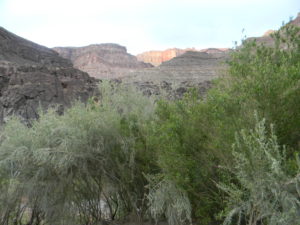
Lee’s Ferry, Marble Canyon, and Glen Canyon Dam
John D. Lee, pioneer of Lee’s Ferry, was an interesting man. He was a different person depending on your perspective. On one side he was a devout member of the LDS and a Mormon pioneer. On the other side he was an outlaw and murderer, accused of participating in the Mountain Meadows Massacre. The massacre killed nearly 120 travelers in a wagon train as part of the “Utah War”. The war was the height of tension between the US Government and the Mormon settlers in Utah.
His status as a fugitive of the US Government led Brigham Young to hide him away, sending him to the remote southern reaches of the Mormon Homeland. His mission was to create a crossing Colorado River to aid in the travel of Mormon settlers. The river is contained by sheer canyon walls for most of its course, except here. Just below Glen Canyon, just above Marble Canyon the walls drop and the river can be accessed from both sides.
John Lee built Lee’s Ferry, and furnished Lonely Dell Ranch. The project was complete 1873. Travelers used Lee’s Ferry to cross the Colorado River. Lee’s Ferry operated for nearly 60 years, until a bridge was built to accommodate the automobile.
Glen Canyon Dam
An abomination was created in 1963. Glen Canyon Dam, also known as Boulder Dam, has been one of the greatest travesties in engineering and land management history. Although you may enjoy Lake Powell, please remember why it is there in the first place. Read more on History of Glen Canyon.
Pearce Ferry and Hoover Dam
The human imprint upon Grand Canyon is apparent at its end. Hoover Dam stands sentinel over Pearce Ferry and the Grand Wash Cliffs just east of Las Vegas, Nevada. Hoover Dam was completed in 1933, and is an engineering marvel that put thousands of people to work during the Great Depression. It provides electricity to the city of Las Vegas and contains myriad recreation opportunities in Lake Mead. However, the official end to Grand Canyon is not the Hoover Dam, but rather Pearce Ferry.
The dramatic cliffs of Grand Canyon appear to plunge right into the river, signaling the end to the Grand Canyon and its National Park at river mile 277. Pearce Ferry was founded much the same as Lee’s Ferry, by Mormon pioneers looking for suitable river crossings.
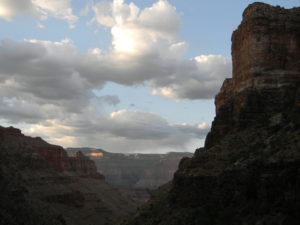
Going Guided
Hiking and exploring Grand Canyon, or any of the National Parks, is a special experience. Although it is possible to see these places yourself, hiring a guide is a great idea. For instance, guiding services provide logistical support, and plan everything for your best possible trip. They provide a great safety net on the trail, and are trained in backcountry medicine. Above all, they provide a depth of knowledge of the region that turns a walk into a true adventure.
Blue Marble Adventure GeoTourism provides all of the support you need, and pairs that with expert geologist/guides. Our backcountry meals use fresh ingredients, and are planned by a professional chef. Furthermore, we provide top-of-the-line gear and passion for the places we explore. In conclusion, you can visit National Parks, but going with a guide can create and even more memorable experience. Don’t be shy, and call us!
The Goat’s Final Word
Your perspective determines where Grand Canyon begins or ends. Do you want time? Or do you want space? Grand Canyon officially begins at Lee’s Ferry near Marble Canyon, and ends at Pearce Ferry (now Hoover Dam). That’s the answer you were looking for! Or was it? Yes it was. In addition to the specific answer, we were also able to explore the more philosophical answers. Fun! Now, your task is to explore Grand Canyon from its beginning to its end, both in space and time.
Read our Blog!
Visit us for hiking adventures in a geologic time machine to Grand Canyon, Utah Canyon Country, and Arizona Red Rocks!

by The Goat | Aug 27, 2019 | Grand Canyon
Top 10 Items for a hike in Grand Canyon
Day hiking in the Grand Canyon, or most anywhere for that matter, is a mind, body, and soul-cleansing experience that has a way of picking up your mood. Whether it’s the peace, the fresh air, the views, or perhaps even the wildlife sightings, hiking is an activity in which everyone should engage as often as possible. However, just like anything else in life, it’s best to go with the right tools in hand to get the job done. Would you try to cook without an oven? Would you try to drive a car that has no engine? Similarly, you cannot begin a hike in Grand Canyon without the essential materials, and The Goat is here to tell you what you need!
For the purposes of this list, we will imagine a day hike to Dripping Springs along the Hermit Trail in Grand Canyon. We assume that you have dressed in the proper clothing. You need solid shoes and a good hat that blocks the sun. Wear synthetic clothing that wicks moisture. Avoid cotton or denim, these materials absorb moisture and can become heavy and unpleasant. Bring a small backpack.
Once you’re dressed, time to hit the trail! The hike to Dripping Springs is 3.25 miles, with great views and less crowds than the corridor trails. Before you go, these are the best things to throw in your pack:

1. Water
Hiking in Grand Canyon is like hiking a mountain in reverse. We preach the mantra to all of our guests that “going down is optional, coming up is mandatory”. Grand Canyon is a dry and sunny place that offers very little, if any, water along the trails. For any hike here: a short trail or even Rim-to-Rim, The Goat recommends 3L/Person. This will ensure that you have enough for the duration of most reasonable day hikes in the canyon. Our hike to Dripping Springs leads to a fantastic natural spring that showers down into a cove. This is a great place to refill and recharge.
However, many trails in Grand Canyon do not have access to water. When you think you have enough water, bring more. Dehydration is a great way to ruin the trip of a lifetime, and a sure bet for a visit to the hospital, or even worse, the funeral home. Bring water and drink it!
2. Sunscreen
Grand Canyon is a very sunny place. In Arizona, the sun shines for over 300 days a year, and Grand Canyon sees every but of that. Many places along the trail provide little shade for most of the day. You will want a solid 30SPF sunscreen to put on your nose, face, neck, and arms. Sunburns can happen pretty quickly in the desert, so it’s a good idea to lather up before you hit the trail.
3. Map, Compass, and the knowledge to properly use them
Although it is important to have a topographic map of the area in which you are hiking, it’s not worth a damn if you don’t know how to read it and navigate with it. Get a compass and some skills to know where you are and where you are going at all times. So sayeth The Goat.
You don’t need to be a master navigator to read a map, however. We recommend Trails Illustrated maps from National Geographic. They are clear and easy to read, and can be readily used to navigate. This compass is a great tool as well. In the event you become lost, you can use it to navigate using landmarks and the map. Along the Hermit Trail, we stop to pinpoint our location. We pick out Vishnu Temple, and using our map and compass find our exact spot on the map.
4. Camera
You’re not seriously considering hiking in Grand Canyon without a camera. Whether you’re a professional on a mission or just a hiker looking to capture some memories, a camera is key in The Grandest. You never know what you may see here. Perhaps a bounding Bighorn Sheep. Maybe a Great Horned Owl. Sometimes a rainbow will pop up! Grand Canyon is an ever-changing landscape that dazzles at every turn. Far-ranging views meet us everywhere along the Hermit Trail.

5. Trail Snacks
Just some simple snacks like granola, fruit, trail mix, cheese, and of course chocolate will do you good when you hit that perfect viewpoint. However, The Goat recommends making it personal. Bring your favorite snacks and eat them heartily. We love to do a great cheese and charcuterie sampler on our day hikes. Champagne anyone? Here at Dripping Springs, you can use the next item on this list to elegantly slice your delicious lunch.
6. Pocket Knife or Multi-Tool
This will come in quite handy when you need to pry a thorn from your boot, slice that piece of fruit in your pack, or even simply add scale to a close-up photo. There is always a use for a knife in the outdoors. Although a knife can get most things done, we recommend a multi-tool with pliers and screwdriver bits for good measure. Tools are especially necessary for any multi-day trips into Grand Canyon, but it is a good idea to have one even on a day hike.
7. Fist-Aid Kit
This can be pretty simple. All you need is some bandages, disinfectant, pain control, and a few other odds and ends such as tape. Check out our Perfect First-Aid Kit blog post for more details. You’re not curing cancer out on the trail, so keep it light and simple. You will want to include tweezers, they are quite useful when dealing with cactus in the desert. Your first-aid kit should be something that allows you to treat normal backcountry injuries resulting from falls, stings, or other minor injuries such as cuts. One of our friends slips and twists here ankle. We tape her up, give her some meds, and we’re back on the trail.
8. Headlamp
So we got a late start and thought we’d make it back to El Tovar just in time for happy hour. Turns out we got caught up gaping at some incredible views and captivating springs, something that even the most hardened Grand Canyon veteran gets seduced into. Don’t worry, dip into your pack and break out the headlamp for that last mile or two, you’ll be glad to have it, especially on the more precarious trails. Hiking after the sun goes down is a thrilling way to see Grand Canyon, especially under a shining moon. However, you will need to see where you’re going, so be sure to bring a headlamp or flashlight to find your way.
9. Trekking Poles
We like to recommend trek poles, particularly in Grand Canyon, as the knees tend to take a beating on the steep downhill grades one finds when trekking here. This is especially true when carrying a pack or any sort of weight. Trekking poles are especially useful on backpacking trips. However, they are useful on day hikes as well, as they provide support and balance on the rocky, rough trails here. Trust us, they helped you on the hike down to Dripping Springs, but you’ll appreciate them even more as they help you propel up!
10. All of your senses
Grand Canyon requires the full use of all of your five senses. Sight, of course, but smell, touch, hearing, and yes, even taste come into play here. As you behold the magnificent views from the rim into the yawning chasm, inhale the smell of junipers and sage. Listen as sparrows, ravens, and eagles chime their songs. Run your fingers along the stone beneath your feet. Drink from Dripping Springs, and taste the power of erosion. If you may feel so bold, pick a flower and eat it, perhaps even lick a rock (a geologist told me to do it).

Going Guided
Hiking and exploring Grand Canyon, or any of the National Parks, is a special experience. Although it is possible to see these places yourself, hiring a guide is a great idea. For instance, guiding services provide logistical support, and plan everything for your best possible trip. They provide a great safety net on the trail, and are trained in backcountry medicine. Above all, they provide a depth of knowledge of the region that turns a walk into a true adventure.
Blue Marble Adventure GeoTourism provides all of the support you need, and pairs that with expert geologist/guides. Our backcountry meals use fresh ingredients, and are planned by a professional chef. Furthermore, we provide top-of-the-line gear and passion for the places we explore. In conclusion, you can visit National Parks, but going with a guide can create and even more memorable experience. Don’t be shy, and call us!
The Goat’s Final Word
There you have it, The Goat’s Top 10 items to bring on a hike in Grand Canyon. As we traversed the Hermit Trail to Dripping Springs, we used each of the items in our packs. We drank all of our water, had a tasty lunch, got back in the dark, and even helped one of our buddies bounce back from an injury. Although you may not use every single one of these items on every hike it’s always a good idea to have them.
Above all, safety and preparation when hiking is key. That may sound stodgy, but nothing ruins a great hike more than some stupid nonsense that could have been avoided if you simply had the right tools. Having enough water and food will keep you alive. Some of these other tools may get you out of jams, but are just simply useful regardless. NPS spends a fairly substantial amount of time rescuing people who get in over their heads. Follow our guide, and you won’t become one of them!
Read our blog!
For adventure hiking vacations in a geologic time machine, see our epic tours in Grand Canyon, Utah, and Arizona!
For geological musings read The Goat’s geology blog.
Follow us on Facebook and Instagram
Explore Further, Be Wild, See Through Time — Blue Marble Adventure GeoTourism
by The Goat | Aug 27, 2019 | Grand Canyon, Hiking
What is the best hiking season in Grand Canyon?
Many of our hikers, clients, and friends are asking about our various destinations and the best time to hit them. Many of those questions revolve around Grand Canyon National Park, one of our most favorite places, and one of the most complex to explain. The reason for this is Grand Canyon’s dramatic elevation changes from rim to river, almost 7000 feet from places on the North Rim. Any given day there are 40 degree differences between the highest and lowest points. Therefore, several answers exist. The bottom line is, however, that there is a hike for every season here. In fact, depending on how adventurous you want to get, there may be some incredible adventures waiting in the off-seasons.
People always want to know the best season to visit Grand Canyon, so here is The Goat’s answer, packaged neatly as usual in a “more information than you thought you were going to get” kind of way. So ask the question, what is the best hiking season in Grand Canyon. Go ahead, ask it. What is the best hiking season in Grand Canyon. Well then, let us hike through the seasons in Grand Canyon!

What is the best time to hike ON the rim?
South Rim
The busiest season in Grand Canyon is the summer, when school is out and tourists abound. Although temperatures can get into the high 80’s and 90’s during the summer on South Rim, it is still pleasant and spectacular hiking, not to mention easy for all skill levels. South Rim amenities are open year-round, and though it receives some snow in the winter, it is generally accessible and fabulous year-round.
Winter on the South Rim can bring snow and cooler temperatures. However, most days are sunny and generally warm for winter. Temperatures on the rim can get into the 60s and 70s some days, although mornings are typically chilly. Hiking in winter on the South Rim may some days require shoe spikes or even snowshoes/crampons. The snow tends to get packed down, which can make trail conditions icy. Just be aware and don’t act a fool!
North Rim
Grand Canyon’s North Rim is absolutely prime in the summertime. Rolling aspen forests grace the approach from Jacob Lake, and oftentimes wildlife abounds. North Rim is far less crowded than the South Rim, making it attractive for people looking to lose the crowds. Like South Rim, hiking along the rim provides great vistas, but with a more contemplative feel. The waterways that have carved Grand Canyon flow mostly from the north, therefore the North Rim is more recessed. In contrast to South Rim with its abrupt cliffs dropping down to the river, North Rim’s descent is more gradual. North Rim is an exciting wilderness experience, and is our “summer adventure of choice” in Grand Canyon.
The North Rim is less accessible in the winter. Roads and amenities are generally open from May 15 – October 15. After October 15, the ranger station at the entrance is not staffed, and the gate is closed. Everything behind the station closes as well, including campgrounds and the Visitor’s Center. Accessing the park must be done on foot, which can require XC skies or snowshoes. Motorized travel is not allowed.
North Rim can receive several feet of snow in the winter. It is, after all, at almost 9,000 feet above sea level, meaning in terms of elevation you are essentially at the ski lifts of many mountains in Colorado or Utah. Winter adventures can be had, but should only be attempted with appropriate gear, acute knowledge of terrain, and winter hiking/camping experience. The North Rim is also much less visited, making it a howling wilderness in the cold months.
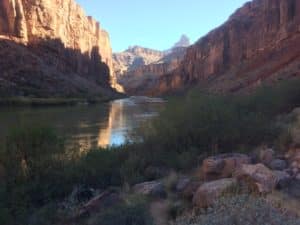
What is the best time to hike below the rim?
Hiking below the rim in Grand Canyon is the best way to experience its grandeur. However, summer can be hot below both rims, and people put themselves in serious danger hiking during the heat of the day in summer. Even a relatively short day hike in July or August can be unpleasantly hot. If you choose to hike below the rim in summer, be sure to start very, very early (like 4am early if you plan to reach the river) to avoid the midday heat and bring plenty of water. The best seasons to attempt day hikes below the rim are spring and fall. Never attempt to hike rim-to-river and back in one day.
Winter months bring excellent hiking conditions. Trails can be somewhat icy at times, but nothing that a decent pair of spikes and a bit of caution can’t handle. Winter is an exceptionally unique time at the canyon, with white snow contrasting against the multi-hues rocks of the gorge. South Rim hikes are generally accessible in winter, and are quite enjoyable. Day hiking from North Rim in the winter is a tougher proposition, given the fact that the roads close. You may access North Rim for hiking purposes in the winter, but you will need to hike the 18 miles in from the entrance station.
What is the best time to backpack in Grand Canyon?
As previously stated, summer can be quite warm below the rim in Grand Canyon. In fact, Inner Gorge temperatures have been known to register at over 130 degrees in the midday sun, making it at best unpleasant, and at worst deadly. Similar to day hikes, backpacking in Grand Canyon during the summer requires early start times and close attention to water intake.
Spring, autumn, and winter months bring fabulous backpacking opportunities; while it stays very cool (20-40 degrees) on the rim, perfect temperatures abound (50-60 degrees) in the Inner Gorge. In addition, permits are more easily procured as few people are applying for them. For a truly grand backpacking experience, plan your trip any time from September-April. May can be good too, but it does begin to get warm later in the month.
What is the best time to hike rim-to-rim?
Backpacking or hiking rim-to-rim is on the bucket list of many hikers all over the world. There are a several factors that make this an outstanding adventure. The most popular route is North Kaibab to South Bright Angel, with stopovers at Cottonwood Creek, Bright Angel Campground or Phantom Ranch, and Indian Gardens. The trail, traverses a part of Grand Canyon with some shade, running springs, developed campsites with running water (not available in the winter), and provides a time of year wherein the crisp waters of the Colorado are highly refreshing.
A truly outstanding route includes a pack rafting trip down the Colorado River, connecting North and South Bass Trails. The hike traverses the route carved by William Wallace Bass, and early pioneer in Grand Canyon. This backpacking trip typically takes 6 or more days, and is one of the most thrilling non-technical hiking adventures in the National Park.
It is easier logistically to do Rim-to Rim in the summer. However, permits to stay at Bright Angel Campground or Phantom Ranch can be tough to come by. Also, services at North Rim are open for a limited part of the season, and trails can even be totally inaccessible if there is snow, which occurs regularly in the cooler months.
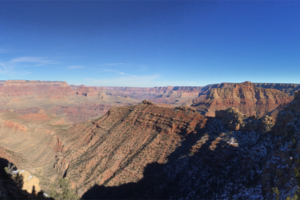
Going Guided
Hiking and exploring Grand Canyon, or any of the National Parks, is a special experience. Although it is possible to see these places yourself, hiring a guide is a great idea. For instance, guiding services provide logistical support, and plan everything for your best possible trip. They provide a great safety net on the trail, and are trained in backcountry medicine. Above all, they provide a depth of knowledge of the region that turns a walk into a true adventure.
Blue Marble Adventure GeoTourism provides all of the support you need, and pairs that with expert geologist/guides. Our backcountry meals use fresh ingredients, and are planned by a professional chef. Furthermore, we provide top-of-the-line gear and passion for the places we explore. In conclusion, you can visit National Parks, but going with a guide can create and even more memorable experience. Don’t be shy, and call us!
The Goat’s Final Word
You wanted to know the best season to hike in Grand Canyon, and there you have it! There is a hike for every season and every hiker here. Hikes along the rim are best in the warmer months, spring-fall. Hiking on the rim can be cool in winter, bring a good jacket. Backpacking trips are best done fall-spring. Day hikes in Grand Canyon are best done in spring and fall, and in summer you should start early. Winter can bring some snow and ice, so you may way to pack a pair of spikes if you are hiking during the cold season. See you on the trail!
Read our blog!
For adventure hiking vacations in a geologic time machine, see our epic tours in Grand Canyon, Utah, and Arizona!
For geological musings read The Goat’s geology blog.
Follow us on Facebook and Instagram
Explore Further, Be Wild, See Through Time — Blue Marble Adventure GeoTourism

by The Goat | Aug 27, 2019 | Grand Canyon
How long does it take to
Hike to the Bottom of Grand Canyon?
“May your trails be crooked, winding, lonesome, dangerous, leading to the most amazing view”
-Edward Abbey
If hiking in the Grand Canyon could be described in a sentence, this is the one. When people ask us how long it takes to get to the bottom of Grand Canyon, this is the image that is conjured. The answer is simple; quite a while. The trip will be several miles, take several hours, require water, food, and gumption, and will then require a trip back out. In fact, the question should not be how long it takes to get to the bottom, but rather how long it takes to get to the top.
As most any guidebook or seasoned Grand Canyon hiker will tell you, getting down is optional, getting up is mandatory. People underestimate Grand Canyon and its challenges each year, on which NPS spends a considerable amount of your tax dollars to affect a rescue. The truth is, it will only take you a few hours, all of which are a breezy downhill, to reach the Colorado River from the rim of Grand Canyon. However, take whatever time you made to the river, about triple it, and that is essentially the time it will take you to come back up topside. Even the most fit hikers fall prey to the whims of Grand Canyon, and any trip to the Colorado River should only be attempted as a backpacking trip and not a day hike.
So how long does it take?
The time also depends on the trails you take, and from which rim you start. Trails from the more popular South Rim are generally shorter, steepers, more well-maintained, and more crowded. Trails from the North Rim are longer, more circuitous, are considerably less maintained, and are far less crowded, particularly by NPS personnel whose resources must be directed to where 85% of the park’s visitors go. in general, a trip to the river from the South Rim will take about 5 hours down, and about 15 hours back up. However, a descent from the North Rim will take close closer to 8 hours to the river, and may take 20+ hours back to the rim depending on fitness.

Going Guided
Hiking and exploring Grand Canyon, or any of the National Parks, is a special experience. Although it is possible to see these places yourself, hiring a guide is a great idea. For instance, guiding services provide logistical support, and plan everything for your best possible trip. They provide a great safety net on the trail, and are trained in backcountry medicine. Above all, they provide a depth of knowledge of the region that turns a walk into a true adventure.
Blue Marble Adventure GeoTourism provides all of the support you need, and pairs that with expert geologist/guides. Our backcountry meals use fresh ingredients, and are planned by a professional chef. Furthermore, we provide top-of-the-line gear and passion for the places we explore. In conclusion, you can visit National Parks, but going with a guide can create and even more memorable experience. Don’t be shy, and call us!
Read our blog!
For adventure hiking vacations in a geologic time machine, see our epic tours in Grand Canyon, Utah, and Arizona!
For geological musings read The Goat’s geology blog.
Follow us on Facebookand Instagram
Explore Further, Be Wild, See Through Time — Blue Marble Adventure GeoTourism
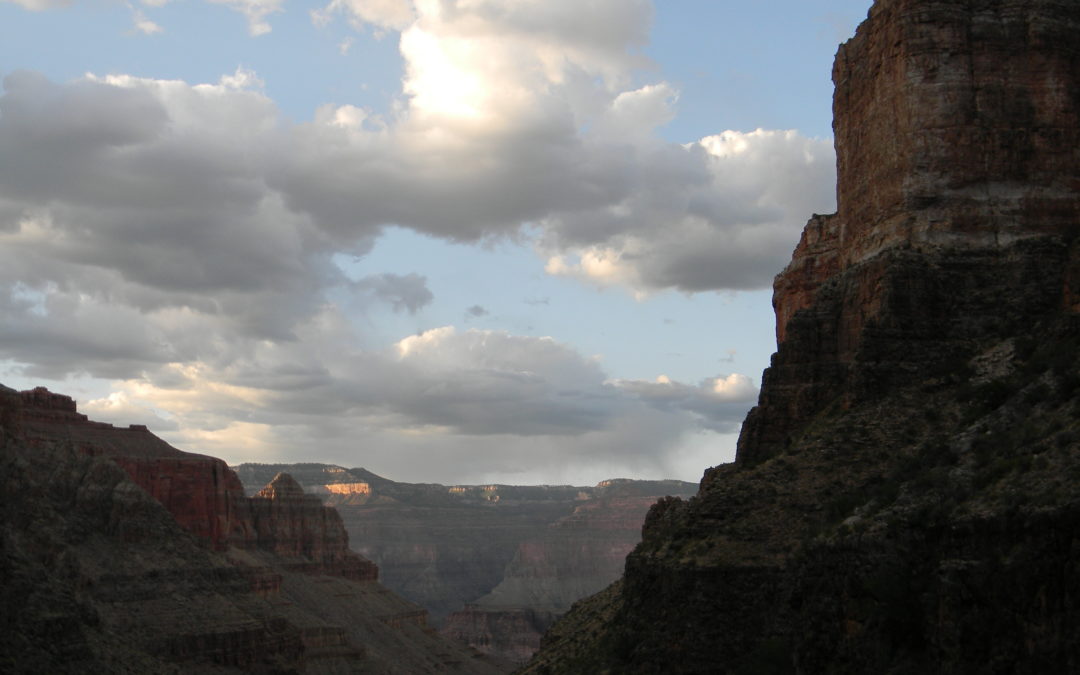
by The Goat | Aug 27, 2019 | Grand Canyon, Hiking
How long does it take to hike South Kaibab?
The South Kaibab Trail is perhaps one of the most popular, well-known, and beautiful trails not just in Grand Canyon, but in the entire National Park System. Of the over 6 million people that visited Grand Canyon in 2016, nearly 10% set foot on South Kaibab, each with their own intentions. Like any hike, you can spend 2 minutes or 2 days on the trail, it’s really up to you. But since we field this question with some regularity, we wanted to dive into a bit more detail.
South Kaibab starts from its perch at over 7,000 feet above sea level just east of the South Rim Visitor’s Center at Grand Canyon. Most folks hop on the park shuttle to get to the trailhead, as passenger car parking at the trailhead is not permitted. The following are the general specs for the trail in its entirety:
Length: 6.9 miles to the Colorado River
Elevation Loss: 4,700 feet
Zone: Corridor
Difficulty: Keep Reading
Like any trail in Grand Canyon, South Kaibab presents outlandish scenery and unique challenges. The most challenging aspect of any hike in Grand Canyon is regaining the elevation that you lose. It is akin to hiking a mountain in reverse, and many visitors breeze a few miles into Grand Canyon before realizing that they need to get back to the rim. South Kaibab is in the Corridor Zone, which means it is patrolled by NPS Rangers, is well-maintained, and you have a high likelihood of seeing other hikers on the trail. The trail is generally pretty wide, route-finding is not something that one need worry about, and there are even facilities along the trail should nature call.

So You Want to Hike South Kaibab….
There are a couple of excellent day hike destinations along South Kaibab, as we (along with NPS and anyone who is not insane) do not recommend going to rim-to-river and back in one day. Here they are with times estimated for the average hiker in good weather:
Ooh-Ahh Point: 1.5 miles round-trip to a spectacular overlook of the Colorado River. (2 hours)
The Tipoff: 6 miles round-trip to the top of the Redwall Limestone and the shaded oasis of Bright Angel Creek. This is one of the most popular day hikes in Grand Canyon ( 6 hours)
Cedar Ridge: 3 miles round trip to a stunning overlook and fabulous respite in the Hermit Shale (3 hours)
Now, more to the point, the hike down South Kaibab is a more direct and therefore steeper route than the at-times meandering nature of its neighbor Bright Angel. This also makes it more challenging, especially on the way up. Though we never recommend that even the most fit hikers in the best conditions attempt this hike in one day, we will quote you a time of at least 11 hours to get to the river and return to the rim. The lack of water, lack of shade, and steep relief make this an arduous single-day adventure, and should not be undertaken.
Want to know more about hiking South Kaibab?
As always, the best way to see Grand Canyon and the South Kaibab Trail is on one of our guided tours, where you will be treated to the epic scenery along with the fascinating story of how this canyon was built layer by world famous layer.
Going Guided
Hiking and exploring Grand Canyon, or any of the National Parks, is a special experience. Although it is possible to see these places yourself, hiring a guide is a great idea. For instance, guiding services provide logistical support, and plan everything for your best possible trip. They provide a great safety net on the trail, and are trained in backcountry medicine. Above all, they provide a depth of knowledge of the region that turns a walk into a true adventure.
Blue Marble Adventure GeoTourism provides all of the support you need, and pairs that with expert geologist/guides. Our backcountry meals use fresh ingredients, and are planned by a professional chef. Furthermore, we provide top-of-the-line gear and passion for the places we explore. In conclusion, you can visit National Parks, but going with a guide can create and even more memorable experience. Don’t be shy, and call us!
Read our blog!
For adventure hiking vacations in a geologic time machine, see our epic tours in Grand Canyon, Utah, and Arizona!
For geological musings read The Goat’s geology blog.
Follow us on Facebookand Instagram
Explore Further, Be Wild, See Through Time — Blue Marble Adventure GeoTourism













